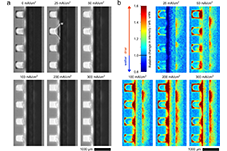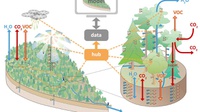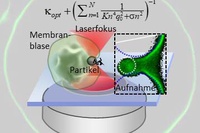Microsystems Engineering
IMTEK: A global player in Microsystems Engineering
The Department of Microsystems Engineering (IMTEK) is an institute of the Faculty of Engineering at the University of Freiburg. We are dedicated to interdisciplinary high-tech research with a strong focus on application.
What is a microsystem?
We speak of a microsystem when several components, technologies and functions are combined into an integrated system on a tiny area. We talk about structures with sizes of 0.1 to 1000 micrometres (1µm = one thousandth of a millimetre). One µm is 100 times finer than a human hair!
How does a microsystem work?
There are very different microsystems. For example, they consist of sensors that detect physical parameters or effects, processors that evaluate the information detected by the sensors, and actuators that react to the evaluated information. They also consist of components for data exchange and „energy harvesting“. Microsystems can, for example, "feel", "think", "act", "communicate" and "feed themselves". Microsystems often comprise small optical elements, semiconductors, but also biological components such as antibodies or cells.
Examples of a microsystem: Your smartphone and your smartwatch!
A smartphone consists of several sensors that are combined in one assembly: You unlock the device via the fingerprint sensor. The gyroscope measures the rotation of the phone around all three axes, so that an app can decide whether a video or picture should be displayed upright or rotated by 90 degrees. With the acceleration sensor, you can determine how far you have run when jogging. The light sensor can automatically adjust the brightness of the display. The smartphone can determine its location and speed via the GPS sensor. In addition, many other instruments are built into your smartphone - without Microsystems Engineering, your smartphone would not even be a functioning phone today.
Watch + Microsystems Engineering = Smartwatch:
Without Microsystems Engineering, the smartwatch would also be "just" a simple watch. It has sensors and other functionalities that display additional information besides the time. The barometer, for example, measures the ambient air pressure, so that sensors can show how many metres of altitude you have hiked or how many steps you have taken. With 3-axis accelerometers, you are able to see how fast you are moving indoor. Heart rate monitors, pulse oximeters and other sensors take up data to track the wearer's fitness.
Microsystems Engineering: Technology for a smart world!
|
Photo: Sandra Meyndt |
Make the world a better placeAddress the complex challenges facing our society in the areas of climate change, energy conservation, pollution, biodiversity, resource efficiency and biomedicine through innovative solutions. Engineering science of the future
Energy and environmental technology, medical technology, sustainable mobility or smart applications in information technology and telecommunications - no industry can do without Microsystems Engineering any more. Active participation in the development of high-tech technologiesWith a broad engineering background, you will not only deal with technical matters. You will also adress aspects of sustainability like energy efficiency, environment or resilience. You will work in an interdisciplinary way and develop forward-looking technologies for present and future generations. |
Main areas of research
The miniaturisation and integration of many functions in a minimal space creates small intelligent systems that achieve great things. Our goal is to develop solutions that help to make life more sustainable, healthier, safer, more comfortable, more versatile and, last but not least, easier.
Biomedical Microsystems
- Mobile diagnostics with innovative minilabs
- Personalised therapies
- Intelligent implants
Intelligent Integrated Microsytems
- Sensors record energy and material flows
- Reduction of energy consumption reduces CO2 emissions
- Electrical energy is harvested from the environment
- Technical systems take direct measures against climate change
Intelligent Materials and Bio-Inspired Systems
- Microelectronics
- Glass injection moulding
- Biogenic materials
- Surfaces with adjustable wetting behaviour
Photonics
- Crystals for generating and manipulating laser light, e.g. for fast and acurate sensor technology for industrial quality assurance
- Optical chips, e.g. for integrated distance sensors for autonomous driving
-
Novel laser scanning microscopes with super-resolution or light-sheet as well as optical tweezers, optical traps and particle tracking to better understand living cells, particle dynamics and infectious diseases
-
Innovative micro-optics, e.g. to pack highly functional cameras into a smartphone
-
Fluidic optics, e.g. to build a microscope from water drops
Examples from research:
Microsystems are flexible and versatile. They contribute to the development of intelligent solutions that are becoming smaller, lighter, more environmentally friendly, cheaper and faster. This makes Microsystems Engineering an innovation driver in almost all production areas and economic sectors.
You can find the whole range of current research here.
Study Microsystems Engineering at the Faculty of Engineering!
Why your studies with us at the Faculty of Engineering are worthwhile - 10 good reasons can be found here!
What do our students say?
 |
"MST in Freiburg is a great degree program because it covers a wide range of scientific interests like hardly any other degree program. For me, this was the decisive point to start an MST degree program, as I have always been interested in almost every kind of natural science and technology. In the course of MST studies, after building up a basic knowledge in all kinds of subject areas, you can specialise in a wide variety of directions, gain many practical skills as well as insights into highly topical areas of research and can follow and expand your own interests." Lea Zausch, master student |
 |
"I have always been interested in how and why electronic circuits work. What excites me about the microsystems technology degree program is that so many technical directions are combined: Microelectronics, micromechanics, microfluidics and microoptics. It's great that here at the Faculty of Engineering you can work practically in the clean room center in addition to the theoretical studies." Roman Oesterwind, bachelor student |
 |
"When I wanted to find out about computer science at the open day, I heard about Microsystems Engineering by chance. After thorough consideration, I enrolled without really knowing what Microsystems Engineering was. I found my strengths and interests in physics and maths combined in the study plan, and it had the advantage that it was offered in the beautiful city of Freiburg 😊 Mirjam Birkhofer, master student |
 |
"I recommend studying Microsystems Engineering at the Faculty of Engineering because you will have many opportunities in industry and research. The courses really relate to real-world applications of advanced technologies and innovations." Ganesh Bandaru, master student |
Is engineering the right choice for me?
Test yourself!
What skills should I have?
In order to be able to design and manufacture microsystems, you need a sound knowledge of natural sciences and technology. For this reason, the main focus in the first two semesters is on physics, mathematics and chemistry, followed by electrical engineering and material science.
In order to show why these basics are necessary, there are application-oriented courses right from the start, such as the System Design Project. Here, the first-year students work together in small groups to build robots that drive autonomously.
The curriculum also includes a course in the clean room, where you can exploreand experience the processes involved in the production of microchips for yourself.
Is Microsystems Engineering right for me?
You should already have some interests in our topics.
With our Online Study Choice Assistant OSA Engineering Sciences, you can check whether Microsystems Engineering is for you. You can compare your expectations with the requirements of the degree programme and get information from professors and students: https://www.osa.uni-freiburg.de/ingenieurwissenschaften/
Are you interested?
Get in touch with us!
Our student advisors are very much looking forward to getting in touch with you!
After high school graduation – Our bachelor degree programme
And afterwards – Our master degree programmes
Doctoral / PhD program and postdoctoral / habilitation programme








